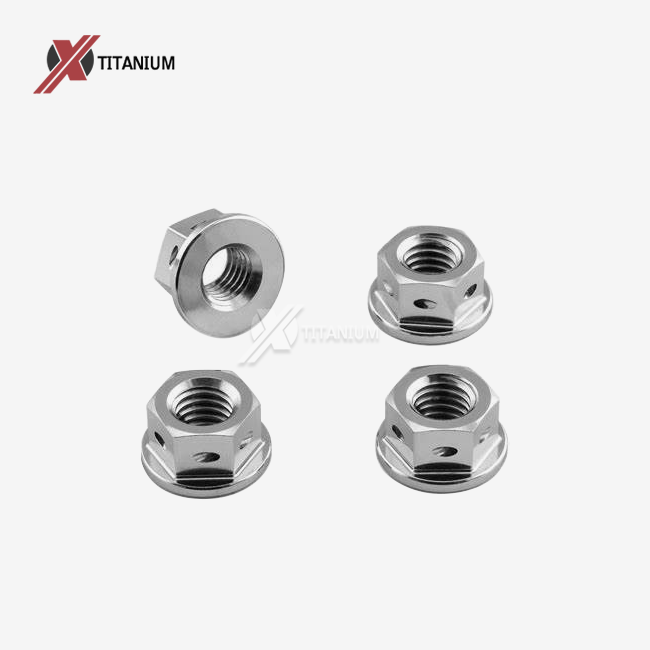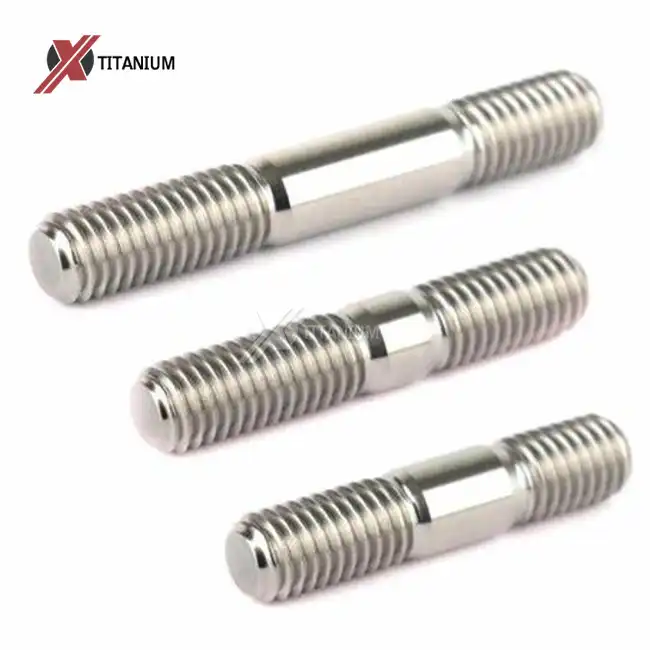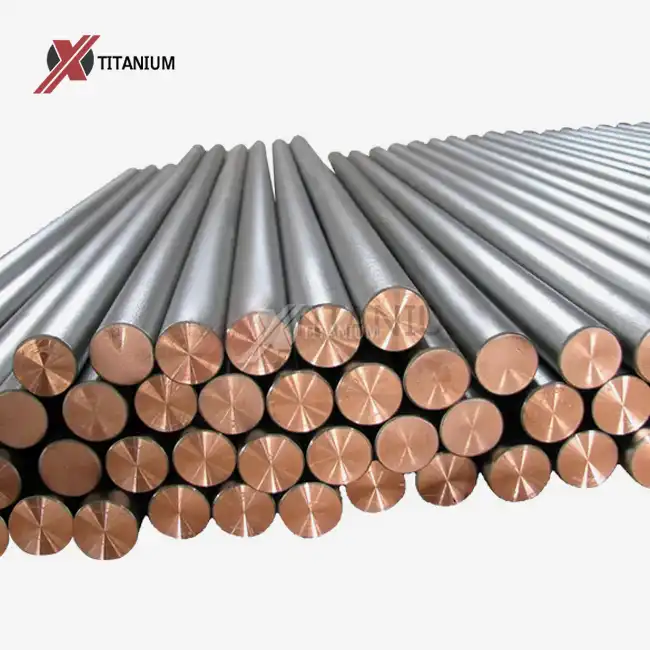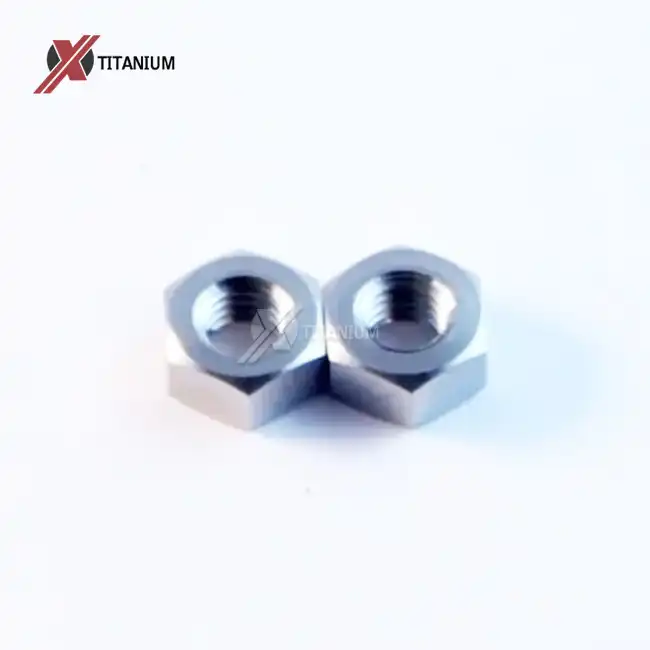Introducing Titanium Sprocket Nuts and Their Unique Properties
Titanium sprocket nuts have gained popularity in high-performance motorcycles and bicycles due to their exceptional strength-to-weight ratio. These specialized fasteners are crafted from high-grade titanium alloys, typically Ti-6Al-4V (Grade 5), which offers an impressive combination of durability and corrosion resistance. The unique properties of titanium make these nuts approximately 50% lighter than their steel counterparts, contributing to overall weight reduction in racing applications.
One of the most notable characteristics of titanium sprocket nuts is their resistance to galling, a form of wear caused by adhesion between sliding surfaces. This property is particularly beneficial in high-stress applications where frequent assembly and disassembly may be required. Additionally, titanium's low thermal conductivity helps maintain consistent torque values even under extreme temperature variations, a common occurrence in motorsports.
However, these advantages come with specific considerations. Titanium has a lower modulus of elasticity compared to steel, meaning it's more prone to elastic deformation under load. This characteristic necessitates a different approach to torquing and maintenance compared to traditional steel fasteners. Understanding these unique properties is essential for anyone working with titanium sprocket nuts, as it informs proper installation and maintenance procedures.
The Role of Sprocket Nuts in Drivetrain Performance
Sprocket nuts play a critical role in securing the sprocket to the hub or axle, effectively transferring power from the engine or pedals to the wheel. In high-performance applications, the integrity of this connection is paramount. Titanium sprocket nuts offer several advantages in this context, including reduced rotational mass and enhanced durability.
The lightweight nature of titanium contributes to quicker acceleration and improved throttle response in motorcycles. For bicycles, especially in competitive cycling, the weight reduction can make a noticeable difference in overall performance. Moreover, the corrosion resistance of titanium ensures that the nuts maintain their structural integrity even in harsh environments, such as off-road racing or coastal areas where exposure to salt and moisture is common.
However, the proper function of titanium sprocket nuts relies heavily on correct installation and torquing. Insufficient torque can lead to loosening during operation, potentially causing misalignment, power loss, or even catastrophic failure. Conversely, over-torquing can lead to stretched fasteners or damaged threads, compromising the nut's ability to maintain proper clamping force. This delicate balance underscores the importance of following precise torquing procedures when working with titanium sprocket nuts.
Essential Tools and Preparation for Torquing Titanium Sprocket Nuts
Before attempting to torque titanium sprocket nuts, it's crucial to assemble the right tools and prepare the work area properly. This preparation ensures accuracy, safety, and the longevity of your components. The following items are essential for the task:
- Calibrated Torque Wrench: Invest in a high-quality, calibrated torque wrench capable of measuring in the range specified by your vehicle or component manufacturer. Digital torque wrenches offer precise readings and are ideal for working with titanium fasteners.
- Socket Set: Use sockets that fit snugly over the titanium sprocket nuts. Ill-fitting sockets can lead to rounding of the nut edges or inaccurate torque readings.
- Anti-Seize Compound: A titanium-specific anti-seize compound is crucial for preventing galling and ensuring consistent torque values. Avoid using copper-based anti-seize compounds, as they can promote galvanic corrosion when used with titanium.
- Cleaning Supplies: Clean microfiber cloths and a suitable solvent for degreasing the threads and mating surfaces. Isopropyl alcohol is often a good choice for this purpose.
- Thread Chaser or Tap: In cases where threads may be damaged or contaminated, a thread chaser can help restore them to proper condition.
- Torque Angle Gauge: For applications that specify torque angle in addition to torque value, this tool is essential for accurate tightening.
Understanding Torque Specifications for Titanium Hardware
Torque specifications for titanium sprocket nuts often differ from those of standard steel fasteners. Due to titanium's unique properties, including its lower modulus of elasticity, manufacturers may specify lower torque values or employ different tightening methods. It's crucial to consult the specific torque specifications provided by your vehicle or component manufacturer.
Some applications may use a torque-to-yield method, where the fastener is tightened to a specific torque and then turned an additional angle. This approach takes advantage of titanium's elastic properties to achieve optimal clamping force. Always follow the manufacturer's recommendations, as improper torquing can lead to fastener failure or damage to expensive components.
Remember that torque specifications may vary based on factors such as thread size, pitch, and the specific titanium alloy used. Never assume that torque values for steel fasteners will apply to titanium equivalents. When in doubt, consult with the manufacturer or a qualified technician familiar with titanium hardware.
Step-by-Step Guide to Properly Torquing Titanium Sprocket Nuts
Following a systematic approach when torquing titanium sprocket nuts is essential for achieving optimal results. This step-by-step guide will help ensure that you complete the process correctly and safely:
- Clean and Inspect: Begin by thoroughly cleaning the threads of both the sprocket nut and the axle or hub. Use a degreaser or isopropyl alcohol to remove any dirt, oil, or old thread-locking compound. Inspect the threads for any signs of damage or wear.
- Apply Anti-Seize: Apply a thin, even layer of titanium-compatible anti-seize compound to the threads. This helps prevent galling and ensures consistent torque readings. Be careful not to over-apply, as excess compound can affect torque accuracy.
- Install the Sprocket: Place the sprocket onto the hub or axle, ensuring it's seated correctly and aligned with any locating pins or features.
- Thread the Nuts: Hand-tighten the titanium sprocket nuts to ensure they're threading correctly. If you encounter any resistance, stop and investigate the cause to avoid cross-threading.
- Set the Torque Wrench: Adjust your calibrated torque wrench to the specified torque value. If using a torque-to-yield method, set the initial torque value as specified.
- Tighten in Stages: Begin tightening the nuts in a star pattern, moving diagonally across the sprocket. Start with about 30% of the final torque value, then increase to 60%, and finally to the full specified torque. This gradual approach helps ensure even loading and prevents distortion.
- Allow Settlement: After reaching the final torque, wait a few minutes to allow the titanium to settle. Titanium's elastic properties can cause it to relax slightly after initial tightening.
- Final Check: Re-check the torque on each nut, again following a star pattern. If using the torque-to-yield method, apply the specified additional rotation at this stage.
- Verify After Use: After a short period of use (typically after the first ride or within 100 miles), re-check the torque on the titanium sprocket nuts. This step is crucial as initial settling can occur during use.
Common Mistakes to Avoid When Torquing Titanium Hardware
While working with titanium sprocket nuts, be aware of these common pitfalls:
- Over-torquing: Titanium's strength can tempt users to over-tighten. Stick to specified values to avoid stretching the fastener or damaging threads.
- Neglecting Anti-Seize: Failing to use an appropriate anti-seize compound can lead to galling and inconsistent torque readings.
- Ignoring Relaxation: Not accounting for titanium's tendency to relax after initial tightening can result in loose fasteners.
- Using Incorrect Tools: Employing uncalibrated torque wrenches or improper sockets can lead to inaccurate torque application.
- Skipping Re-checks: Failing to verify torque after initial use is a common oversight that can lead to problems down the road.
Conclusion
Properly torquing titanium sprocket nuts is a critical skill for anyone working with high-performance motorcycles or bicycles. The unique properties of titanium necessitate a careful and informed approach to achieve optimal results. By understanding the characteristics of titanium, using the right tools and techniques, and following manufacturer specifications, you can ensure the safety, performance, and longevity of your drivetrain components.
Remember that working with titanium hardware often requires specialized knowledge and tools. If you're unsure about any aspect of the process, it's always best to consult with a professional or the manufacturer. For those seeking high-quality titanium components, including sprocket nuts and other fasteners, Baoji Chuanglian New Metal Material Co., Ltd. offers a wide range of titanium products suited for various applications. For more information or to discuss your specific needs, please contact us at info@cltifastener.com or djy6580@aliyun.com.




